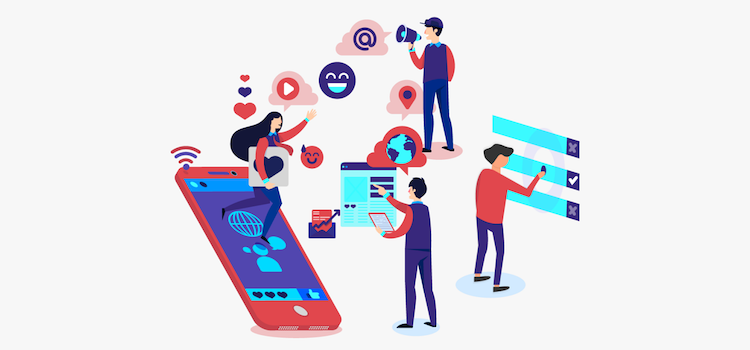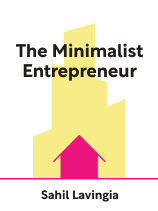

This article is an excerpt from the Shortform book guide to "The Minimalist Entrepreneur" by Sahil Lavingia. Shortform has the world's best summaries and analyses of books you should be reading.
Like this article? Sign up for a free trial here.
What’s the key to marketing your small business? How can you boost sales for your business?
Marketing for a small business can be difficult because of a limited budget and minimal resources. However, Sahil Lavingia’s book The Minimalist Entrepreneur says you don’t need much to start advertising.
Here’s how to market your small business, according to Lavingia.
Launch and Market
When you have your infrastructure set up, you’re ready to go. Lavingia says at this point you’ll launch and begin to market simultaneously. Below we’ll look at how to market your small business effectively.
He advises against paid advertising because it’s too expensive and too broadly targeted for a minimalist business. He says you don’t need to spend any money on marketing (Shortform note: Although much contemporary marketing advice suggests moving away from traditional paid advertisement, the US Small Business Administration says it can still be quite effective. They say in surveys, people indicate a much higher level of trust for TV, print, and radio ads, over online ones. So, if you do decide to pay for marketing, traditional advertisements may be the most effective route). You can do it all yourself because you’ve already established yourself with your target audience.
He also advises against having a launch party just yet. Instead, start by “cold calling” to educate people on your services, then begin more widespread social media marketing, then have your launch party.
1. Spread the Word
Lavingia recognizes that most people, especially creative types, hate doing sales and marketing. So he advises thinking of sales as “education” about your product or service.
Start spreading the word about your business by reaching out individually to people in your target community, like this:
1. Connect with experts and influencers. Scour social media to find subject matter experts, such as journalists, bloggers, and influencers who have posted about businesses similar to yours. For example, if you’re creating a photo-editing app, look for people who have YouTube reviews of similar apps, or bloggers who write about photography and photo editing. Make a list of everyone you can find. Message them and offer to show them your product. You may even want to take them out for lunch if they’re local. Ask these people for their feedback and learn from them. Don’t necessarily try to sell them on your product, or ask them for reviews or promotion. Just educate them and show it off. Simply making these connections puts you in a network that can eventually generate referrals and customers. Lavingia did this with hundreds of people.
2. Target potential customers in your community. Search your internet communities for people who might be interested in your product and reach out to them individually. Message them and just tell them a little about what you have to offer. For example, Lavingia’s website Gumroad offered a way to sell digital products to people. So he scoured the internet looking for people who were selling digital products in a less efficient way, like emailing the product to every customer. He wrote a quick message to each of those people telling them he had created a more efficient way to automate the process of selling digital files and welcoming them to check out his website if interested. He did this with thousands of people. (Shortform note: This is called “cold messaging.” Tips for successful cold messaging include: Keep your message brief and authentic.)
3. Don’t get discouraged. Most people will ignore you or say no. Don’t take it personally. Remember, this is your passion, so just keep sharing enthusiastically.
According to Lavingia, this will be how you generate sales in the beginning. He advises that you always be authentic and open with your customers, creating relationships with them, so they’ll be inspired and feel part of a community.
2. Set Up Your Funnel
The next step in marketing will be to set up your “funnel.” In Lavingia’s model, the funnel is made up of social media at the top and email in the middle, which will funnel your sales to you at the bottom.
Lavingia recommends setting up your funnel as follows:
Top of the funnel: social media
Your social media presence will be your farthest-reaching marketing vehicle. Here you’ll want to create content that will be interesting and engaging enough to generate followers. Some advice Lavingia offers for managing your social media content includes:
- Create accounts for your business and yourself separately. If people are attracted to your business, they may want to follow you personally. This way you create “fans” rather than just “customers.” (Shortform note: Forbes says turning your customers into “fans” means creating brand loyalty. When someone is a fan of a brand, they’re explicitly not a fan of competing brands. And the thing that turns customers into fans is excellent customer experience. So your customer service can be just as important as your product itself.)
- Post on your social media accounts every day.
- Share your pages in the communities your existing customers are part of.
- Generate content people can like, comment on, and share. Twitter’s retweet feature can generate a lot of exposure if someone with a big following retweets your post.
- Instagram, YouTube, TikTok, and Pinterest may work better for certain kinds of products. You have to find which sites work best for your business.
- Share content that has value, not minutiae like your meals. Post your thoughts and ideas, educational, inspirational, and entertaining content. Be personable and authentic.
- Share your business journey. People enjoy following that progress.
- Use the reactions and comments to gauge what people like and want to see more of.
Middle of the funnel: email
As soon as you have social media followers, start collecting email addresses. Lavingia says every email subscriber is worth much more than a social media follower, because they’ve already indicated their interest, and you can reach them directly. His business has over 200,000 email subscribers, and he says this list is the business’s most valuable asset.
When you have someone’s email address, think of them as a friend and treat them accordingly. He offers some tips on how to go about compiling and using an email list:
- Create something small you can give people for free in exchange for their email addresses. For example, you might create an artwork or a pdf, and post on your social media that you’ll send the download file to anyone who gives you their email address.
- When you have a particularly popular post, respond to it with a link to sign up for your email list.
- Create a blog or newsletter, and encourage people to subscribe to it.
- Set up your payment process so every customer gives their email address when they check out.
- Set a regular schedule for sending out content to your email subscribers. Try a weekly or monthly newsletter.
- Don’t spam people or overdo it. Try out different things and if a lot of people unsubscribe, change your approach.
- Reward your loyal customers by emailing them discounts for leaving reviews or sharing on their social media.
(Shortform note: In The 1-Page Marketing Plan, Allan Dib says an email list is a low-cost and low-effort way to turn already interested people into paying customers. It’s a way to develop a relationship with your customers, introduce new products, and offer promotions. Instead of using your regular email account, he recommends you consider using an email marketing platform like MailChimp, which can help you automate, personalize, and optimize your email content.)
Bottom of the funnel: sales
When you have your funnel set up and are consistently creating content for your social media and email subscribers, you’ll start to see sales come in. At this point, you’re ready to celebrate. Lavingia says after you have about 100 customers and successful sales, it’s time to plan your launch party.
3. Have a Launch Party
According to Lavingia, most companies don’t use the launch party in the most effective way to market small businesses. He says it shouldn’t be about starting your business; it should be about celebrating its early success. And you should celebrate with your customers. He says you should invite all of your customers to your launch party, so they can feel they’ve built the business with you. Invite them to bring their friends and families. This will spread the word of your business even further, and your customers will be helping you sell to their communities. This strategy will earn you loyal and repeat customers, which are essential for a sustainable minimalist business.

———End of Preview———
Like what you just read? Read the rest of the world's best book summary and analysis of Sahil Lavingia's "The Minimalist Entrepreneur" at Shortform.
Here's what you'll find in our full The Minimalist Entrepreneur summary:
- Detailed advice for starting your own business without venture capital
- How to run your business sustainably and contribute to the world
- Why you don’t need to spend any money on marketing






